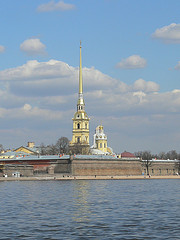

Saint Peter and Paul Fortress is situated on the Zayachi (Hare) Island and makes the nucleus of the historic part of Saint Petersburg. Stronghold was founded in May 1703 thus marking beginning of the city. Russian Emperor Peter I the Great designed Peter and Paul Fortress himself. It contains 6 bastions connected by curtains of defensive walls, 2 ravelins, crownwork as well as earth ramparts. In 1730s and 1740's base of the citadel was covered by stone slabs. Despite its impressive fortifications it was never used in military engagement. Instead it was used as a high ranking prison for political and criminal prisoners. Despite its close proximity to the banks of Neva river no one ever succeeded in escaping from this prison. Some of the most famous inmates what were incarcerated here included Tsarevich Alexei, only surviving son of Peter I. Young prince disapproved of many of reforms of his father and secretly hoped to overturn many of them upon ascension to the throne. He further infuriated his father by marrying a simple peasant girl. Peter tortured his own son within walls of the fortress and eventually ordered his execution.
Another famous prisoners included famous princess Tarakanova. Her origins remain unclear, however she claimed to be a daughter of Empress Elizabeth and thus had right to the Russian throne. Catherine the Great that ruled over Russian Empress was of German origin and deposed her own husband. Although few people in Europe honestly believed that Russian Empress Elizabeth had any unknown children, Tarakonva became a good card in the hands of European monarchs to take control of the Russian throne. Polish opposition that fled Poland after it became part of the Russian Empire seized the opportunity and invested large sums of money into solidifying myth of a Russian princess. The situation became too dangerous and Empress Catherine ordered special operation led by Duke Tolstoy to the shores of Italy. There he convinced princess Tarakanova to marry him on one of the Russian ships. Once woman came to the battleship she was arrested and delivered to Russian capital of Saint Petersburg. There she was imprisoned until her alleged death. Few people believed that she died and several eye witnesses later claimed to see a nun who was none other but princess Tarakanova.
After Decembrist Uprising was put down in 1825 its organisers were kept here and five of them were executed by the order of a new Emperor Nicholas I. Other famous "residents" of the main prison in Russian Empire included writers Nikolai Chernyshevsky, Maxim Gorky and many others. Fyodor Dostoyevsky spent several days in Ravelin after he was caught along with his friends for participation in an anti- government plot. All of them were sentenced to die by hanging for high treason. On a day of the execution he was taken out of his prison cell and led to the gallows. However in the last second when Dostoyevsky was certain his life is about to end a messenger arrived proclaiming that all the conspirators were pardon by the emperor and new punishment involved exile to Siberia. Dostoyevsky later described this scene in his famous book "Idiot" as a story that Prince Myshkin tells to his aunt and her daughters.